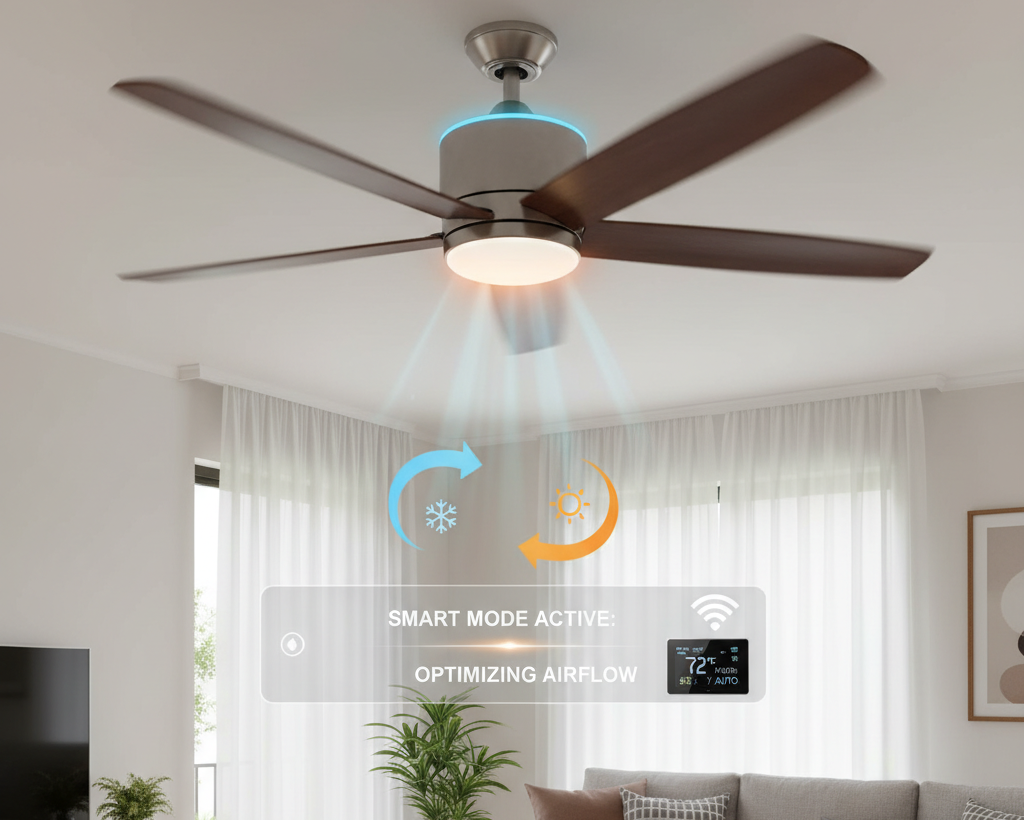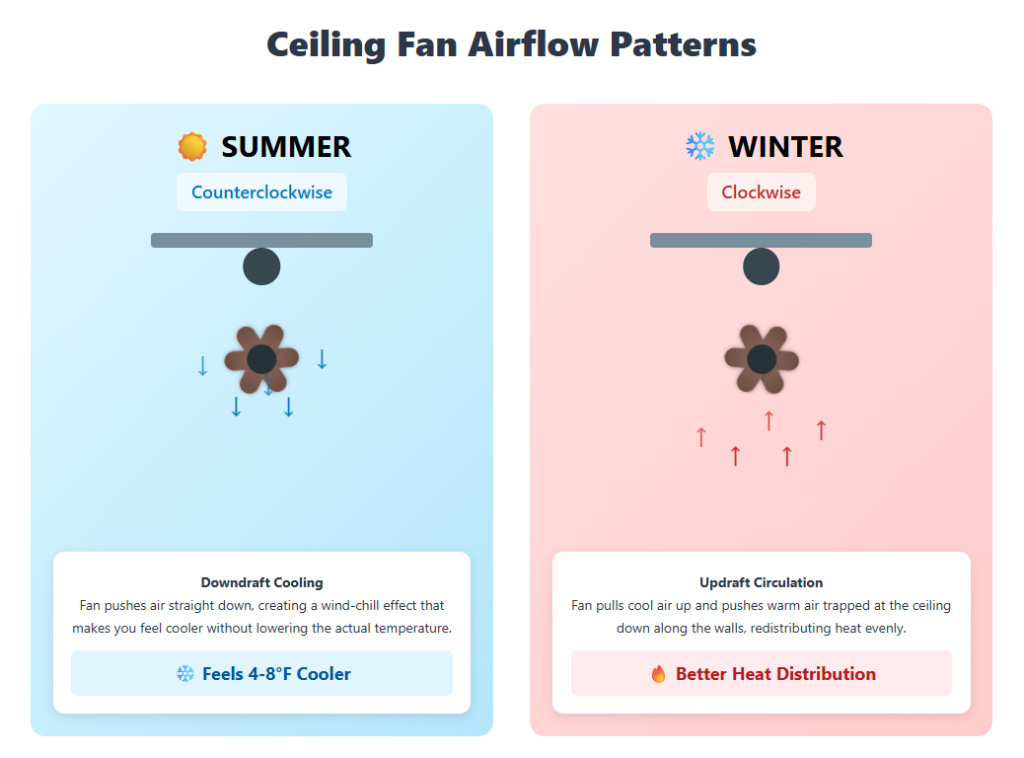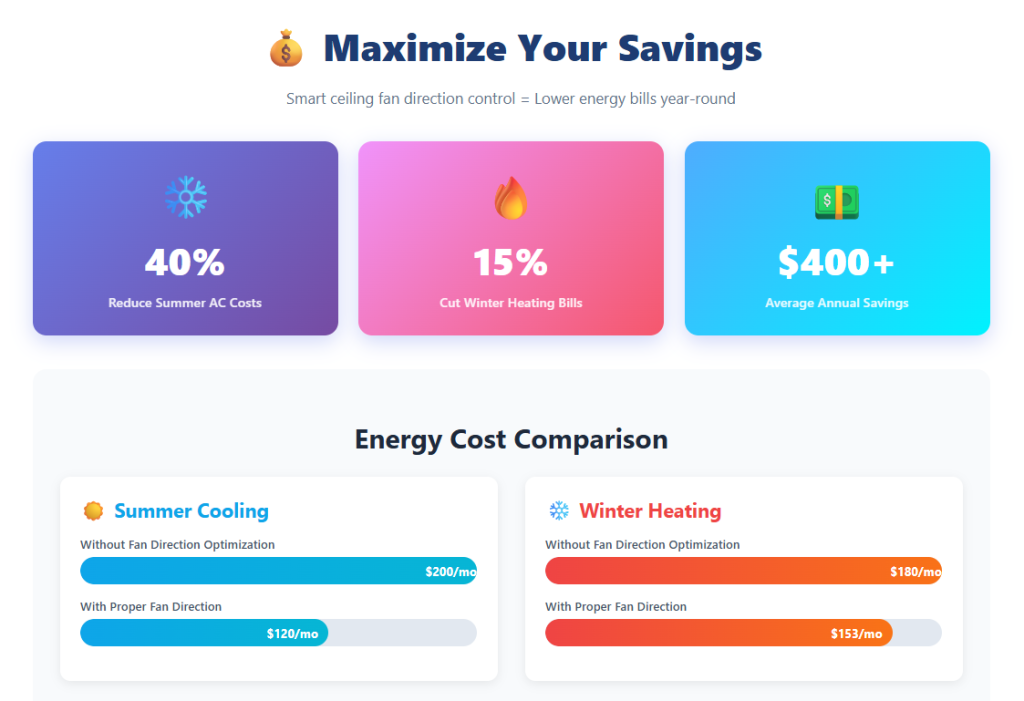Ever wonder why your ceiling fan spins but doesn’t always make you comfy? The secret is the ceiling fan direction; a low-cost way to feel good all year round. Whether you turn your ceiling fan clockwise or anticlockwise is really important for maximizing your comfort and minimizing your energy bill. Modern technology has made it easier than ever to adjust fan direction by season, improving efficiency and comfort.
Today, we’ll explore how properly directing ceiling fans can transform your space and your wallet. We bust the ceiling fan direction myth and share easy tips to get it right. You’ll also learn how to change the ceiling fan direction and how it works with air conditioning. Let’s dive into this cool tech that makes your home super cozy and saves cash.
Key Takeaways
- Proper ceiling fan direction significantly influences comfort and energy savings throughout the year.
- Counterclockwise direction cools rooms in summer, while clockwise warms them in winter, maximizing efficiency.
- Switching directions seasonally can reduce energy bills by up to 30% over time.
- Regular maintenance and the right fan size enhance airflow and efficiency, contributing to cost savings.
- Understanding common misconceptions about ceiling fan direction can improve effective usage and conserve energy.
Table of Contents
- Understanding the Basics of Ceiling Fan Directions
- Ceiling Fan Direction for Summer
- Ceiling Fan Direction for Winter
- Typical Ceiling Fan Direction Myth
- How to Change Ceiling Fan Direction
- Maximising Savings with Proper Ceiling Fan Direction
- Additional Considerations for Ceiling Fan Directions
- Conclusion
- FAQs
Understanding the Basics of Ceiling Fan Directions
Fundamentally, the direction of ceiling fans determines the airflow in a room. Modern ceiling fans are equipped with a switch that allows them to rotate in either direction, clockwise or counterclockwise. Actually, this is not just an anomaly of design; it relies upon the physics of airflow and air movement, and on how they influence the perception of temperature.
Ceiling fans do not either heat or cool the air; they circulate it to give the illusion of comfort. The ceiling fan’s current makes the difference between a cooling breeze and a slight redistribution of heat. Properly installed, this can help you save up to 30% on your energy use, and it is a highly cost-effective addition to your heating and cooling systems.
Here is the Science Behind the clockwise and counterclockwise direction.
- Counterclockwise Rotation: Counterclockwise directs air downward, creating a flow that feels like a fresh breeze. This chill from the wind helps you feel cooler without touching the room’s real heat. It’s great for the ceiling fan’s summer direction when the heat gets too much.
- Clockwise Rotation: Clockwise rotation lifts air up, blending warm top air with cool air below. This flow sends heat along the walls, gently warming the room. It’s best for the ceiling fan direction in winter to stay toasty inside.
Choosing the right direction of the ceiling fan matters a lot for every season. Otherwise, incorrect placement makes rooms stuffy in summer and chilly in winter, wasting energy.

Ceiling Fan Direction for Summer
Nothing is more refreshing than the heat of summer than cool air, and fans are of great assistance in this regard. During summer, set your ceiling fan to counterclockwise for a powerful downward breeze. Ceiling fan direction brings a breeze this summer, which sweeps the sweat off your skin, and you feel 4-8 degrees cooler than the room temperature without even noticing.
Also, use medium or high speed for the best ceiling fan summer direction effect. Consequently, this lets you push up your thermostat, cutting AC use and saving on bills. Experts say ceiling fan direction for cooling can save 10 to 15% on cooling costs.
Why the Direction of Ceiling Fan for Summer Works:
The fan’s direction in summer chills you without extra power use. Here’s how it makes hot days feel better and costs less:
- The downward airflow creates a wind-chill effect, such as a light breeze outside.
- With a warmer thermostat set, you save money by running your AC less frequently.
- Air is evenly distributed, so no part of the room feels hot.
Avoiding Pitfalls in Ceiling Fan Direction for Summer
Lots of people forget to switch the direction after winter, missing out on cool air. Stand under the fan to check; you should feel a strong, fresh breeze. If not, flip the fan direction switch to the summer setting. This breeze is great in humid spots, drying sweat fast for comfort. Also, wipe the fan blades often, as dust blocks airflow and weakens cooling performance.
Ceiling Fan Direction for Winter
When it’s cold, the ceiling fan’s winter direction keeps your home warm and super cozy. Set your fan to clockwise to lift cool air and push warm air down. This winter, direction mixes the heat trapped near the ceiling with cooler air below, making your room feel warmer without cranking the heater.
Also, use low speed to avoid chilly drafts in the ceiling fan direction in winter. Consequently, this lets you lower your thermostat by 2 to 4 degrees, saving big on heating costs.
Why Clockwise Ceiling Fan Direction Works in Winter:
Warm air rises, leaving cold spots near the floor, especially in tall rooms. The clockwise ceiling fan direction in the winter setting fixes this by spreading heat evenly:
- It pushes warm air down walls for a soft, cozy feel without drafts.
- You spend less on heating by using less energy.
- It’s fantastic for high-ceiling rooms where warmth hides up top.
Tips for Optimizing Winter Ceiling Fan Direction
- Set the fan to low speed to move air without any cold feel.
- Use in tall rooms to pull heat down to where you are.
- Pair with sound insulation to hold warmth and save more energy.
By adjusting your ceiling fan for winter, you can make it a year-round, energy-efficient tool that complements your heating system.

Typical Ceiling Fan Direction Myth
The ceiling fan direction myth persists, with some believing fan direction doesn’t matter or that fans only work in one mode. Another misconception is that fans directly cool rooms, when they actually cool people through air movement. Some also think clockwise rotation in winter causes drafts; it is not true at low speeds.
Correct ceiling fan orientation plays a significant role in conserving energy. By overlooking the direction switch, one misses out on considerable comfort and cost savings.
Let’s bust the common misconceptions.
- Myth: Fans Cool Rooms: They create a perceived cooling effect, not a temperature drop.
- Myth: Direction is Irrelevant: The summer and winter ceiling fan directions serve distinct purposes.
- Myth: High Speed in Winter Helps: High speeds can create a cooling effect; low speed is best.
Understanding these facts ensures you use your fan effectively and avoid wasting energy.
How to Change Ceiling Fan Direction
Switching the direction of the ceiling fan is very easy, and most people can do it. The motor has a ceiling fan direction switch on the motor housing, which most fans use to change modes. First, it is safe to switch off the fan and then locate and switch the switch. Next, adjust the airflow to suit the season.
Here is a step-by-step guide to changing the direction of a ceiling fan.
- Turn off the fan and wait until the blades stop moving altogether.
- Find the ceiling fan direction switch on the fan’s base or side.
- Flip the switch counterclockwise for the ceiling fan’s summer direction, or clockwise for its winter direction.
- Start the fan and feel the air to make sure it’s correct.
No switch? Check your remote or manual; some fans use a pull chain. This quick fix lets you set your fan to hot or cold with ease.
Ceiling Fan Direction with Air Conditioning
Pairing your fan with AC makes your home super efficient and saves more money. In summer, the ceiling fan direction with air conditioning should be counterclockwise to spread cool air. This lets you set AC higher, using less power for the same comfy feel. In winter, a clockwise direction helps shift warm air, easing the heater’s workload.
Optimising Ceiling Fan Direction in Summer or Winter with HVAC
- Summer Synergy: Counterclockwise in summer boosts AC cooling, saving 3 to 5% per degree.
- Winter Boost: Clockwise in winter helps spread heat, making your heater work more effectively.
- Pro Tip: Aim the AC vents away from the ceiling fan when cooling to avoid air mixing.
To direct the ceiling fan during cooling, the AC vents should be installed to blow out, not toward the fan, or they will interfere with the downdraft.

Maximising Savings with Proper Ceiling Fan Direction
The best thing about fan direction is cutting energy bills year after year. Ceiling fan direction for cooling lowers AC use in summer, keeping you nice and cool. Ceiling fan direction winter trims heater use, warming your home with ease. The correct directions can save you hundreds of dollars over time.
Tips for Maximum Efficiency
- Switch the ceiling fan direction in spring and fall for summer and winter modes.
- Use high speed for the ceiling fan in summer and low speed in winter, to avoid drafts.
- Put fans in rooms you use most, like bedrooms or living spaces
Additional Considerations for Ceiling Fan Directions
To get the most out of your fan, keep a few extra factors in mind:
- Fan Size and Room Fit: To start, larger rooms need bigger fans with stronger airflow to maximize benefits.
- Blade Pitch: Fans with a steeper blade pitch have a higher air movement and increase the effects of both summer and winter direction.
- Maintenance: Also, have blades cleaned regularly to maximize airflow and efficiency, regardless of the fan’s direction.
To simplify changing your fan’s direction and settings, consider upgrading to a modern model. For example, many come with convenient add-ons, such as remote controls or smart home features.
Conclusion
Knowing where to place the ceiling fans is a simple yet proven way to stay comfortable and avoid wasting energy year-round. All one has to do is turn a fan clockwise in winter and counterclockwise in summer to improve living conditions and reduce the burden on the heating and cooling system. This small modification can save you a fortune on your power bills and is a cheap, simple addition to any homestead.
On top of this, the latest innovations of smart technology have made it even more convenient to change the direction of fans. Whichever way you choose, manually with the fan or with the smart feature to automate your routine, the benefits are the same: more comfort, less energy consumption, and a more sustainable home. Therefore, rely on this simple trick to find a comfortable, affordable year-round home.
FAQs
During winter, ensure the fan runs on low speed in a clockwise direction. This tends to push warmer air down the room and lowers the heating expenses by 10–15%.
In summer, you should set your fan to rotate counterclockwise on medium or high speed to create a cooling effect. It assists with air circulation and makes your space feel a few degrees cooler.
Not entirely. Ceiling fans do not alter the actual air temperature in the room; they circulate air, making the room feel cooler or warmer. They are best used with AC or heaters to increase comfort and save energy.
Yes! Adjusting your fan direction by season reduces pressure on your HVAC system. This can cut energy costs by up to 30% over the year while maintaining the same level of comfort.
Older models might not include a reverse switch. In that case, you’ll need to manually adjust the motor wiring or upgrade to a modern reversible or smart fan, which offers easy seasonal control.











